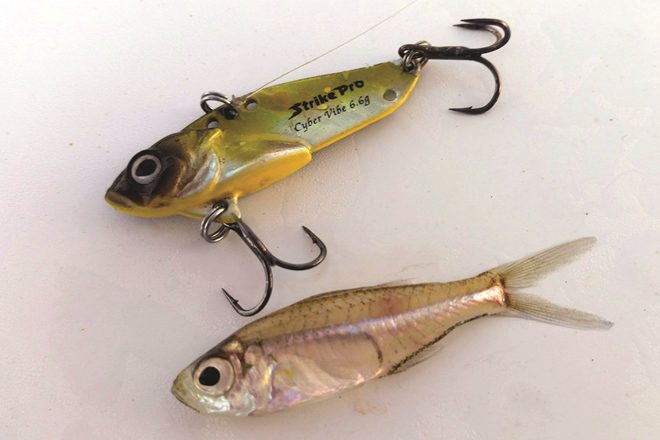



G’DAY everyone, as we discussed last month, the fishing was fantastic and it still is thanks to the record rainfall in February. In this month’s article I will pass on some tips for using vibration lures.
They are both easy to use and of course highly effective. Three main styles of vibe lures include hollow plastic models with a rattling ball bearing inside, soft vibes and finally metal vibes, which are commonly called blades. Not only do these lures appear realistic in the water, when used correctly they look like common baitfish, and most importantly generate strong vibrations in the water.
All fish have lateral lines that run down the side of their bodies and are designed to pick up vibrations in the water. This is one of the main reasons anglers using vibration lures enjoy such success.
In recent years I have favoured vibes over the common soft plastic lures because soft plastics are fitted with a weighted jig head and single hook that only gives one point of exposure for fish to successfully grab. Vibes, however, come fitted with two sets of treble hooks that are more reliable when it comes to increasing your hook-up rate.
Using vibration lures is effective in both shallow and deep water, which makes them very versatile, and they appeal to almost all species of fish. They can be cast and retrieved with a hop of the rod tip and a gathering of the slack line via a wind of the reel.
If the wind and tide allows, I like to cast the vibes out and let them sink to the bottom, drifting without winding them in at all. It is important to make short and consistent movements with the rod tip so they hop up and down evenly across the bottom. I like to keep the hops to short intervals, which can be done by implementing even 50cm flicks of the rod tip.
When fishing deep water with vibes, I use my sounder to find bait schools and fish holding close to the bottom, then position the boat directly above and lower the lures straight down to the bottom and into the target zone. Once on the bottom, I use the same short and even 50cm jigging action as mentioned.
The main tip is when you jig the rod tip up, you must then release it immediately to let the lure flutter straight back to the bottom. I emphasise this because most fish take the lure as it sinks, which means the flick up is what gets their attention, while the take occurs on the drop.
On the odd occasion I have even tried using vibration lures to cast at fish such as trevally busting the surface. I then retrieve the lures at a reasonable speed, which keeps them subsurface. This has netted good results. In a nutshell, all anglers should have a couple of vibes in their tackle boxes because they are fun to use and catch many different species.
Take care and get out on the water as much as you can because the fishing is really good and will continue to be all through the oncoming winter.
 Bush ‘n Beach Fishing Magazine Location reports & tips for fishing, boating, camping, kayaking, 4WDing in Queensland and Northern NSW
Bush ‘n Beach Fishing Magazine Location reports & tips for fishing, boating, camping, kayaking, 4WDing in Queensland and Northern NSW









